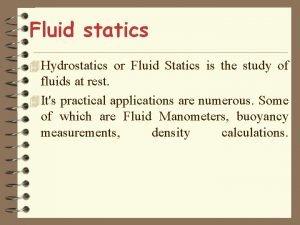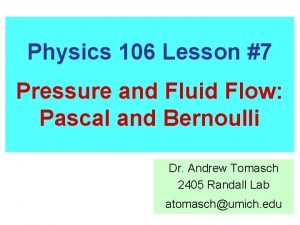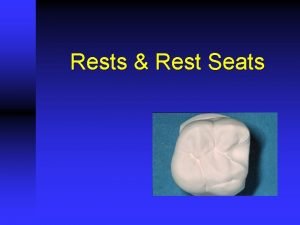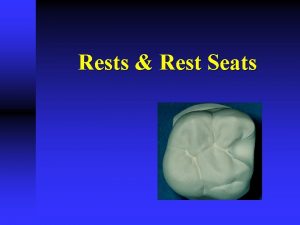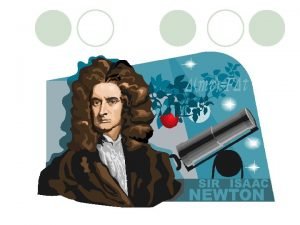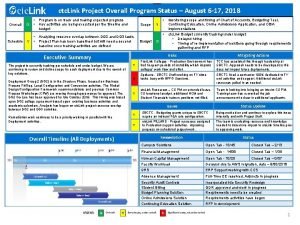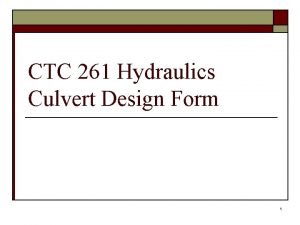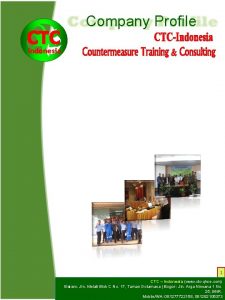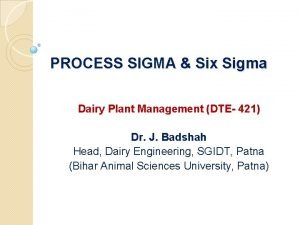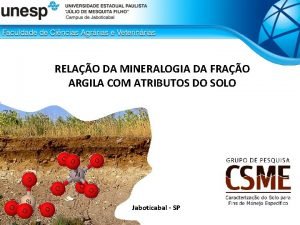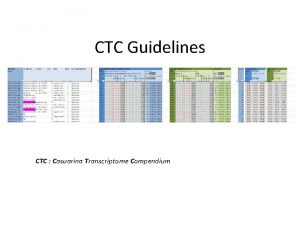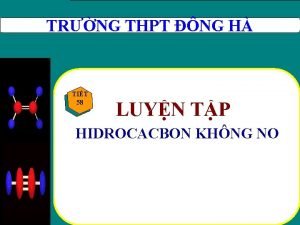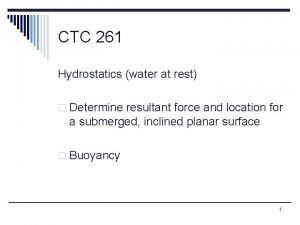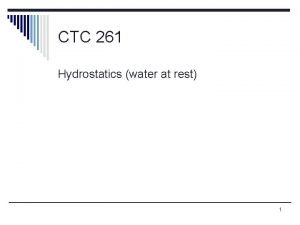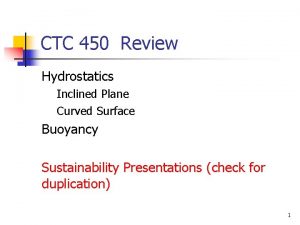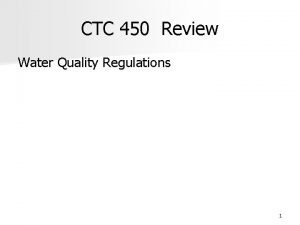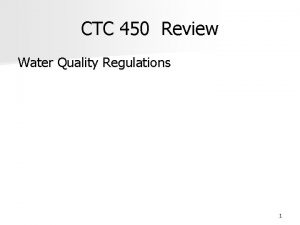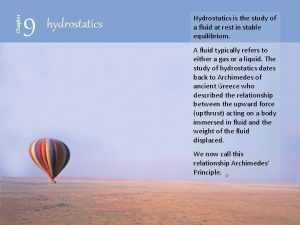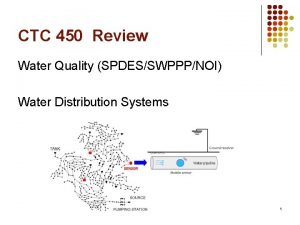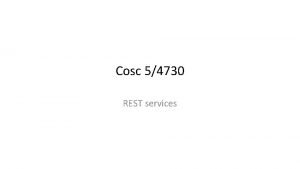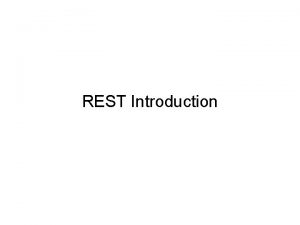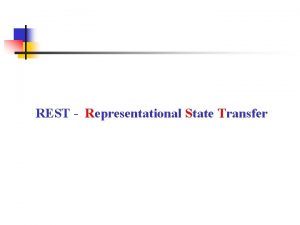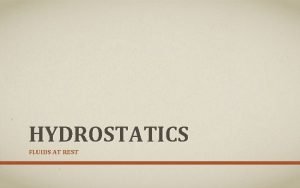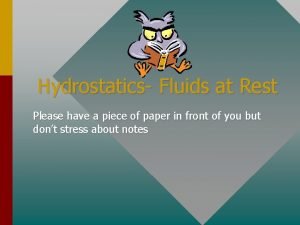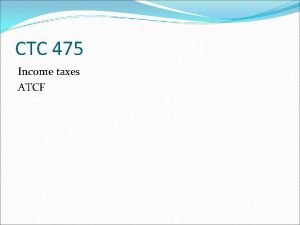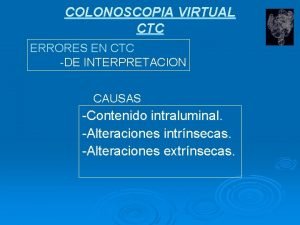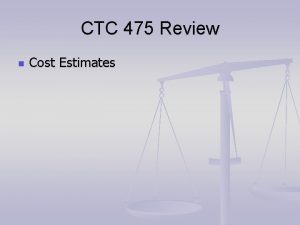CTC 450 n Hydrostatics water at rest 1



























- Slides: 27

CTC 450 n Hydrostatics (water at rest) 1

Review Biology Review Types of Organisms of interest in water and wastewater treatment BOD (seeded and unseeded) 2

Objectives n n n Know common fluid properties Understand difference between absolute and gage pressure Know how to convert pressure to pressure head Know how to calculate hydrostatic pressure and resultant force on a horizontal plane surface Know how to calculate hydrostatic pressure and resultant force on a rectangular, vertical plane surface 3

Fluid Properties Property SI USC/FPS Temperature K (273+C) F (9/5 C+32) Mass Kg Slug Length Meter Foot Time Sec Force Newton Lb Pressure Pascal (N/m 2) Psi Gravity Constant 9. 81 m/sec 2 32. 2 ft/sec 2 4

Other fluid properties Specific Weight-Gravitational force per unit volume q Water at 20 C (68 F): 9. 79 k. N/m 3 (62. 3 #/ft 3) Mass Density-mass per unit volume q Water at 4 C (39 F): 1000 kg/m 3 (1. 94 slugs/ft 3) Specific Gravity-Specific weight of a liquid/specific weight of water at some std. reference temperature 5

Water Properties – See Blackboard n Dependent on water temperature and pressure 6

Absolute vs Gage Pressure n Gage pressure is the difference between absolute pressure and the surrounding ambient pressure (atmospheric pressure) n Absolute pressure is the gage pressure plus atmospheric pressure n In civil engineering applications, gage pressure is the commonly used pressure 7

Atmospheric Pressure n Approximately 14. 7 psia n What is the equivalent gage pressure? 8

Hydrostatic Pressure and Resultant Force on a Horizontal Plane Surface n Pressure is uniform because the depth of liquid is the same across the plane surface n Pressure=Specific weight * liquid depth (h) 9

Hydrostatic Pressure on a Horizontal Plane Surface n n n Cylinder of water 1 foot high; area = 1 ft 2 What is the pressure at the bottom of the cylinder? P=Specific Wt * Height of Water P=62. 4 #/ ft 2 F=Pressure * Area F=62. 4 # 10

Force on Horizontal Plane Surface The magnitude of the force is 62. 4# Where does it act? 11

Center of Pressure-Horizontal Plane Surface Corresponds to the centroid of the horizontal plane surface n n Circle Triangle Rectangle Composite of simple shapes 12

Centroids and Moment of Inertia See Blackboard 13

Hydrostatic Pressure n n Varies linearly w/ depth Is a function of specific wt and depth Acts through the center of pressure Acts normal to the exposed surface 14

Pressure and Pressure Head In civil engineering water pressure (psi) is often expressed in terms of water head (ft) 15

Converting Pressure to Pressure Head n n Pressure Head = Pressure/Specific Weight Example: Atmospheric pressure = 14. 7 psia (14. 7 psia)(144 in 2/ft 2)/(62. 4#/ft 3)=33. 9 ft H 2 O The specific gravity of mercury (Hg) is 13. 6 therefore the pressure head in terms of Hg would be 2. 49 ft 16

Manometer Principles Point 1: Pressure=0 Point 2: Pressure=h*specific weight of liquid Point 3: Pressure=Pressure @ 2 Point 4: Pressure=Pressure @ 3 –d*specific weight of liquid in vessel 4 • As you go down pressure increases. • As you go up pressure decreases. • As long as you know pressure at some point (& fluid properties & d/h values) you can determine pressures at all other points. d http: //www. energymanagertraining. com/energy_audit_i nstruments/manometers/principal%20 of%20 manomete r. htm 17

Manometer Example n A manometer is mounted on a city water supply main pipe to monitor the water pressure. Determine the water pressure in the pipe (psi). n Answer: 16. 8 psi 18

Break 19

Vertical, rectangular plane surface n n Consider a dam section 1’ wide and 10’ deep What is the pressure distribution and resultant force of the water pressure? Pressure @ top = 0 Pressure @ bottom = 624 #/ft 2 20

Vertical Rectangular Plane Surface n Magnitude of force = Avg Pressure * Area F=3, 120 # n Where is the resultant force located? n q q Centroid of the dam (rectangular) Centroid of the pressure distribution (triangular)? 21

Example (1/2) n Assume that freshly poured concrete exerts a hydrostatic force similar to that exerted by a liquid of equal specific weight n What is the force acting on one side of a form that is 8’V by 4’H used for pouring a basement wall 22

Example (2/2) n n Concrete specific wt = 150#/ft 3 Area = 32 ft 2 F=Avg Pressure * Area F=19, 200# = 9. 6 tons 23

Example (Horizontal and Vertical Water Pressure) Class Exercise: who can get correct answer? n An L-shaped rectangular gate can rotate about the hinge. As the water level rises, the gate will open when the level reaches a critical height. If the length of the lower horizontal arm is 1 meter, find the critical height. (Neglect the weight of the gate). n Answer: h=square root of 3 (m) 24

What if Vertical Rectangular Plane Surface is Submerged? 25

Review Questions n n n What is the difference between gage and absolute pressure? What is the atmospheric absolute pressure at sea level? What is the atmospheric gage pressure at sea level? What is the difference between specific weight and specific gravity? What is the difference between specific weight and mass density? What is the relationship between the two? What is the equation for hydrostatic pressure acting on a horizontal plane surface? How do you calculate the resultant force of pressure acting on a horizontal plane surface? Where is that force located? Does hydrostatic pressure vary linearly with depth? The pressure distribution on a vertical rectangular plane surface is either triangular or trapezoidal. When is it triangular? When is it trapezoidal? Can you use the “average pressure” method for vertical rectangular surfaces? Can you use the “average pressure” method for vertical triangular surfaces? 26

Next n Hydrostatic pressure on an inclined plane surface n Hydrostatic pressure on a curved surface n Buoyancy 27
 Fluid statics formulas
Fluid statics formulas Hydrostatics
Hydrostatics Penyiku dari perbandingan trigonometri sin 300 adalah
Penyiku dari perbandingan trigonometri sin 300 adalah Water and water and water water
Water and water and water water Elearning gizmo
Elearning gizmo Ghost cries purgatorium
Ghost cries purgatorium Cingulum rests
Cingulum rests Cingulum rest
Cingulum rest Newton's second lawlaw
Newton's second lawlaw Rest and rest seat
Rest and rest seat Ctc link sfcc
Ctc link sfcc Ttc ctc
Ttc ctc Ctc form 1
Ctc form 1 Company profile with ctc
Company profile with ctc Ctc link
Ctc link Ctc en ctq
Ctc en ctq Ctc
Ctc Ctc tsi testing
Ctc tsi testing Ctc en ctq
Ctc en ctq Ctc sheet
Ctc sheet Ctc
Ctc Deep speech
Deep speech Autism spectrum disorder authorization california
Autism spectrum disorder authorization california Ctc britain
Ctc britain Código cis banreservas
Código cis banreservas Ctc anken
Ctc anken Ctc loss
Ctc loss Ctc link
Ctc link
